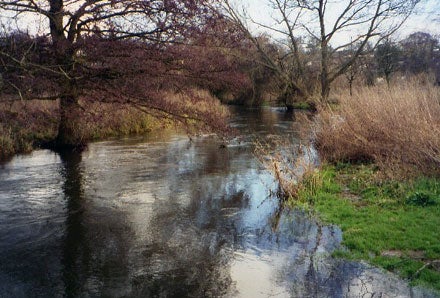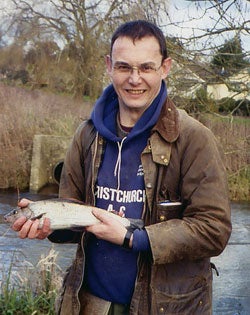| MARK WINTLE |
| Mark Wintle, an angler for thirty-five years, is on a quest to discover and bring to you the magic of fishing. Previously heavily involved with match fishing he now fishes for the sheer fun of it. With an open and enquiring mind, each week Mark will bring to you articles on fishing different rivers, different methods and what makes rivers, and occasionally stillwaters, tick. Add to this a mixed bag of articles on catching big fish, tackle design, angling politics and a few surprises. Are you stuck in a rut fishing the same swim every week? Do you dare to try something different and see a whole new world of angling open up? Yes? Then read Mark Wintle’s regular weekly column. |
| DEFINITELY NOT THE WINDRUSH One of the rivers high on my list of venues to visit during the 2003/4 season was the Oxfordshire Windrush. I last fished this river many years ago, had some tremendous catches of chub and barbel, and was looking forward to revisiting it. I had high hopes of getting to the Windrush after Christmas but bad weather and poor conditions made planning difficult. I was reliant on my old friend, Jimmy Lee, who grew up in Witney, near Oxford, before moving to Dorset more than thirty years ago, and still returns for a day or two each season, to make the arrangements. But the rain gods had other ideas. On Thursday the 5th February, the Windrush was fining down nicely after an unsettled week, and Jimmy phoned to say the trip was on for Saturday; but later that night continuous and torrential rain in Oxfordshire put the Windrush, Ray, Ock and Thame on flood alert.
In relatively dry Dorset, all seemed okay, and I bought plenty of maggots and casters in readiness for the trip. When I returned home on Friday evening, Jimmy phoned to say the trip was off. The big question was where we could go as an alternative. The Dorset Stour was four feet up and rising. The tidal Dorset Frome at Wareham might be okay for some big dace, so we arranged to meet there in the morning. A Tough Time on The Frome The swim I picked had around eight feet of water at high tide running over gravel. The flow was steady but the strong wind was funnelling down the river. I could get my 10 BB Avon float to travel down the swim in a straight line all right, though it took tight control of the line but bites were simply unforthcoming. After an hour and a half, I wound in at the end of a long trot to find a dace on the end. It promptly fell off. Jimmy was fishing a swim about four hundred yards further downstream amongst the many moorings. It was slightly more sheltered down there, and he did get a few fish, four dace up to half a pound and a small roach. Having learned that a swim nearer to the bridge had produced some good dace the previous day, I moved upstream. The extra water that had come in overnight made the swim especially boily, however, and my only reward in two hours fishing was a mending sea trout kelt of about a pound. Not only was the swim hard going, I seemed to find a couple of snags with monotonous regularity, and steadily worked through a packet of hooks. Having met up with Jimmy mid way through the morning, we had agreed that if there was no improvement in sport by two o’clock we would go and have a couple of hours on a private chalk stream in Dorset. Jimmy had obtained access here and there was a good chance of grayling and dace. Jimmy reappeared at two o’clock and we set off for the chalk stream. This is one of several under-rated streams that can produce surprisingly good fishing when the going is tough elsewhere. Not least, because being spring fed it will run high but clear when the main rivers are full of muck. As we suspected, the chalk stream was running high, about two feet above normal, and very fast. Jimmy regularly walks the stream banks and had spotted that shoals of dace and grayling had moved upstream to one or two areas that had previously not held any fish. One of these swims looked particularly promising. It was a steady glide about thirty yards long with a clean gravel run for its entire length. Half way down some alders trailed into the water but it looked possible to work the float past these. The stream is only around eight yards wide, and eventually feeds into one of the major Dorset rivers. Jim reckoned he’d had enough of fishing for today and decided to watch me fish to see how the swim fished in the high conditions. Dace and Trout on a Chalk Stream
Baiting with two maggots I started trotting, feeding twenty or thirty maggots every trot just upstream. It was not long before the float stabbed under. I struck to find myself attached to a lively fish that put an impressive curve in the rod. It soon revealed itself an out of season brown trout of about a pound, and fortunately shook itself off the hook. The next two fish were also brown trout. This didn’t bother me unduly for I expected the trout to respond quickly to the maggot feed. Once they’d had their go, they would vacate the swim to let me coax the dace and grayling into feeding. After about half an hour I got my first dace. It was only a small one but still a welcome sign. The next two or three dace were similarly small. It was interesting in that the trout had all taken the bait about a yard in front of the trailing branches yet the dace were lying just beyond them. It was a case of working the float past the branches to get the dace. This made striking tricky, as I had to ensure that the line didn’t foul the branches when playing the fish back past the branch. As soon as I hit the fish, I ducked the rod tip underwater until the fish was past the branches. The gusty wind from the morning had dropped completely and in the strengthening sunshine, it was almost spring-like. A male kingfisher was trying to woo a female, and all around the robins and blackbirds were chasing each other in the streamside scrub. Decent Grayling at Last Just after this, I hooked the bottom. Because I was using a 0.14mm hooklength, the main line broke and I lost my float. Retackling with a lighter float taking 5BB, I soon found that this altered the presentation such that I got more bites from the dace. Half a dozen small dace quickly followed. After these, I finally caught two successive fish that made half a pound each. Not monsters, but for me this season it has been very lean as far as decent sized dace are concerned with a best of only nine ounces. These two fish were the typical pigeon-chested female dace that show at this time of year. This far south the dace can spawn as early as mid February.
Ten minutes later, I struck a heavy fish right under the trailing branches. I was forced to concede line briefly as the fish used the swift current to its advantage. Letting the rod do the work, it started to tire, and I slowly eased it upstream. I was pleased to see a good grayling of a pound and three-quarters come to the surface. In the fast current, it was not easy to get it into the landing net but I got it second attempt. A quick photo, and it was back on its way. What a cracking fish! After this, I managed to pick up a dozen or more dace, all downstream of the bush, plus another out of season trout but no more grayling. All too soon, it was time to pack up. It had been a fine day out on the river. Plan B might have failed but our final destination had turned up trumps. Venues like this small chalk stream can be prolific but cannot sustain much angling pressure. As this river is private, I shan’t reveal where we went, as the owners would not appreciate poaching. Most waters like this are private, and not available on club tickets, and in the long term this maintains their viability. We did get to the Windrush before the end of the season, but that’s a story for another day. Next week: ‘Flake and float – quest for a Stour Bream’ |
















